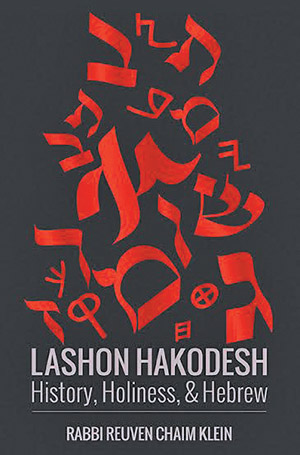

The term “Lashon Hakodesh” means different things to different people. It’s generally translated as “the holy language.” And what that language is can also mean different things to different people. Author Rabbi Reuven Chaim Klein knows there are no definitive answers on the development of Lashon Hakodesh and does his best to offer various theories and opinions. This is in line with what Professor Haym Soloveitchik so astutely noted: history is not a question of logical possibilities, but of historical probabilities.
In “Lashon HaKodesh: History, Holiness & Hebrew” (Mosaica Press) (ISBN-10: 1937887545 ISBN-13: 978-1937887544), the author takes a historical and linguistic look at Lashon Hakodesh and its derived languages. The title conveys the message that Lashon Hakodesh and Hebrew are two different languages. Klein dedicates a chapter showing that Modern Hebrew, while connected to Lashon Hakodesh, is clearly not identical to the elemental Lashon Hakodesh language.
The book is a fascinating and engaging reference to the topic. For the traditional reader who wants to know the origins of the Divine language being used for sacred purposes, the book will likely answer most questions. For the reader who simply wants to know the history and development of ancient Hebrew and Aramaic, the book will also be extremely rewarding.
References such as “A History of the Hebrew Language” by the late Professor Angel Sáenz-Badillos and “A Social History of Hebrew: Its Origins Through the Rabbinic Period” by William Schniedewind of UCLA take a purely academic approach to the development of the Hebrew language. While not an academic text, Klein’s book takes a hybrid approach to the topic and quotes liberally from academic sources, while retaining a strong focus on traditional rabbinical sources.
The book’s eight chapters and four appendices are a fascinating read. Proficiency, or even a basic understanding, of Hebrew is not a required prerequisite for reading the book. Albeit the reader with a basic understanding of Hebrew will certainly have a greater appreciation for the topic.
The first half of the book progresses from the Lashon Hakodesh of primordial man—known as Adam—to how the languages were split up at the incident of Migdal Bavel (Tower of Babel), to what languages Abraham spoke, with Chapter 4 detailing the languages of the Jews during their time in Egypt.
The author notes in Chapter 1 that the words of Lashon Hakodesh intrinsically reflect their meaning. At a metaphysical level, the words of Lashon Hakodesh express the very essence of what they describe, while the words of other languages simply represent a consensus of the masses. As a God-given language, Lashon Hakodesh’s words are divinely inherent, while the connection of words to their meaning in other languages is simply arbitrary.
It is in this respect that Klein quotes Austrian-British philosopher Ludwig Wittgenstein, who had the notion that words don’t have inherent meaning and are only defined by their usage, when he wrote that “the meaning of a word is its use in the language.”
The following is a summary of some of the key points in the book:
Chapter 5—“Replacing Lashon Hakodesh”—this chapter is interesting in that it shows the dynamic nature of the language. The author details the many different dialects that developed from the original Biblical Hebrew, such as the various dialects of Mishnaic Hebrew.
Chapter 6—“The Language Wars”—this chapter deals with the fascinating events and controversies that started when Eliezer Ben-Yehuda attempted to modernize Lashon Hakodesh and create the Modern Hebrew language. This was met with significant opposition by many. The language wars lasted from roughly the late 1800s until the mid-20th century.
Klein notes that Rabbi Mosher Sofer observed that Lashon Hakodesh has a paltry vocabulary compared to other languages. He explains the dearth of words by noting that while other languages have evolved through contributions and additions, Lashon Hakodesh is limited to those words spoken by God to His prophets. The goal of Ben-Yehuda was to both fill that gap and build on the entire historical Hebrew language.
With that, it’s not clear what linguistic category Modern Hebrew falls into. Klein notes that some consider Modern Hebrew to be a Semitic language since it’s built on the original ancient Lashon Hakodesh, while others consider it to be an Indo-European language.
Of the four appendices, I found the first to be the most interesting. Titled “The Scripts of Lashon HaKodesh,” Klein spends 25 pages detailing the different scripts (fonts) of the language, from the Phoenician period, to Moabite script, to traditional Ashuri script.
In “Lashon HaKodesh: History, Holiness & Hebrew,” Klein has written an enjoyable and engaging work. The book offers numerous solutions to many seemingly imponderable problems, and offers reconciliations of seemingly contradictory issues. The book is a great starting point for anyone who wants to learn about the history, development and evolution of Lashon HaKodesh, Aramaic and Hebrew, especially from the traditional Rabbinic point of view.
The book can be viewed and ordered on Amazon online at: http://www.amazon.com/dp/1937887545
By Ben Rothke










